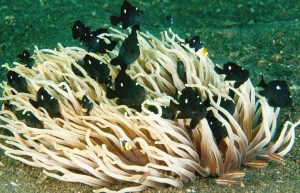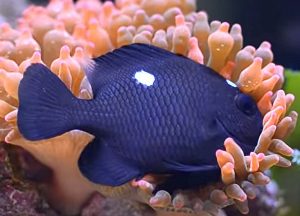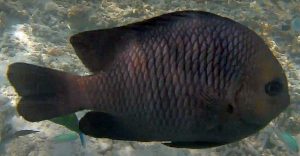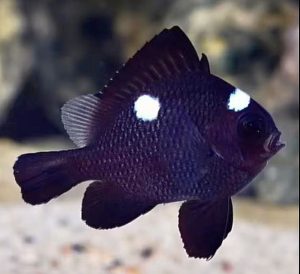Domino Damselfish (Dascyllus trimaculatus) known to tropical fish keeping enthusiasts as 3-Spot Domino Damselfish, Three Spot Damselfish, or Threespot Dascyllus are native to the Indo Pacific from the Red Sea and East Africa, to the Pitcairn Islands, southern Japan, areas of the Phillippines, and Australia.
Adults Domino Damselfish are usually found in small groups around coral heads or large rocks at depths down to 185 feet where they feed on algae, copepods, and various other planktonic crustaceans.
Like clownfish, juvenile Dascyllus trimaculatus are frequently found in shallow waters where they enter into relationships with large carpet anemone (Stichodactyla gigantea) when they are available, or hiding among the spines of diadema sea urchins and branching corals.
Domino Damselfish have a dark gray to black body color with two lateral white spots and one spot between the eyes. The lateral spots in some individuals are significantly reduced in size, and the forehead spot is often totally absent.
As juvenile Domino Damselfish mature into adults, their aggressiveness increases and their bright white spots
fade. Adults Males and females cannot easily be differentiated by size or color.
Domino Damselfish are reef safe and are best housed in a mature reef or FOLR aquarium of at least 55 gallon capacity with a sand or fine crushed coral substrate and plenty of aged live rock arranged into crevices and overhangs for them to hide among. They will not harm corals in a reef setup and will even enter into relationships with several species of anemone.
Juveniles are fast growers that can be housed in a FOLR tank with larger tankmates like dwarf angelfish, puffers, cardinalfish, etc. They should not be housed with groupers, eels, sharks, or rays.
Because of their aggressive nature, it’s better to keep a single specimen in lieu of a group or pair unless you have a very large tank with plenty of live rock for territories.
Domino Damselfish have been bred in an aquarium environment but because of the challenge in feeding the fry and the easy availability of the species, it is not a common practice.
A mated pair of Domino Damselfish will occasionally make their way into an aquarium where, like clownfish, they will perform a mating “dance” over a cleaned rock, shell, or side of aquarium glass. The female will lay her adhesive eggs after which the male fertilizes them. The male will aggressively guard and aerate the eggs until they hatch, in approximately 7 days. The tiny fry are “plankton feeders” that require a diet of rotifers (specifically Brachionus Plicatilis) which feed on phytoplankton. In their natural habitat, the hatched larvae drift with the current as plankton, feeding on zooplankton and phytoplankton before settling to the bottom.
Domino Damselfish are omnivores that feed on algae, copepods, and a variety of planktonic crustaceans in their natural habitat. In an aquarium environment with substantial mature live rock in their aquarium, they will greedily eat a variety of meaty foods, flake foods
, pellets, and frozen herbivore preparations. Several small feedings daily are recommended in lieu of a single large feeding.
Domino Damselfish (Dascyllus trimaculatus) are readily available to tropical fish keeping enthusiasts and can be purchased from most fish shops or online from retail, wholesale, and commercial breeders at reasonable prices.
Available in purchase sizes of 3/4″ to 1-1/2″ or larger; you can expect to pay from $7.50 to $20.00 per fish.
Minimum Tank Size: 55 gallons for singles
Aquarium Type: Reef or FOLR
Care Level: Easy
Temperament: Aggressive
Aquarium Hardiness: Very Hardy
Water Conditions: 72-80°F, dKH 8 to 12 , pH 8.1 – 8.4, sg 1.020-1.025
Max. Size: 5.5″
Color Form: Black, White
Diet: Omnivore
Compatibility: Reef
Origin: Indo Pacific
Family: Pomacanthidae
Lifespan: 20 years
Aquarist Experience Level: Beginner






2 Responses to “Domino Damselfish (Dascyllus trimaculatus)”
Trackbacks/Pingbacks
[…] Three Stripe Damselfish, Domino Damselfish, and most species of clownfish; juvenile Four Stripe Damselfish will often enter into symbiotic […]
[…] and zooplankton during daylight hours and shelters among the coral heads during the night. Like Domino Damselfish and most clownfish; juvenile Three Stripe Damselfish will often enter into symbiotic relationships […]